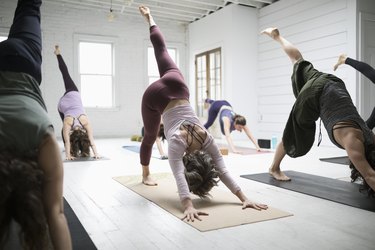
A woman may need a procedure known as d&c either alone or in combination with a hysteroscopy for a number of reasons. These include miscarriage, suspected tumor, or because of irregular periods or spotting. Once you feel better, you may wonder how soon you can exercise after d&c and a hysteroscopy.
Understanding the Procedure
Video of the Day
A dilation and curettage (d&c) can diagnose a problem, or be used to additionally treat a condition. The d&c may also follow a procedure known as a hysteroscopy, which involves inserting a small tube into the vaginal opening to examine uterine or cervical issues. The d&c itself starts with dilating the cervical opening, then using a curette tool to remove tissue from the uterine lining.
Video of the Day
A d&c may be done in a doctor's office or at a hospital, usually as an outpatient procedure. You may be given a sedative to help relax your muscles, as well as some type of anesthesia. The dilation is done with a series of rods, while the curettage is used either with a scraping or suction tool.
If you are in training or simply don't want to lose momentum in your fitness regimen, ask your doctor about exercise after d&c and hysteroscopy during your consultation. After the procedure, your doctor will give you an update if there are any precautions you may need to take, based on whether there were any complications from the d&c.
The First 24 Hours
Even if you're a fitness fanatic, working out after d&c probably won't be on your mind immediately afterward the procedure. For one thing, you may need to be monitored at the doctor's office or hospital for several hours after the d&c.
According to the Cleveland Clinic, it's normal to feel some slight pain after returning home. Light bleeding is also common. In addition, the amount of sedation or type of anesthetic needed for the procedure may be stronger than you realize. For that reason, exercise after d&c and hysteroscopy should be nonexistent to minimal in the first day or two.
If you wish, you can ask your doctor about very light yoga after d&c, or simple in-bed stretches. These relaxing moves can help ease the strain of bed rest.
Working Out After D&C
After the first day following a d&c, most women can begin non-strenuous activities, advises the American Pregnancy Association. Those might include a stroll outside, light weeding in the garden, or gentle yoga after d&c.
Within a few days, you can probably resume your normal workout routine. It's normal to have a bit of cramping or light bleeding for up to two weeks after the procedure. But if those symptoms extend beyond two weeks, or if the bleeding becomes heavy, discontinue exercise for now and call your doctor. The same holds true for chills and fever, dizziness and strong-smelling vaginal discharge.
Finding Your Motivation
While there are usually no physical reasons why you shouldn't exercise soon after a d&c, there are plenty of emotional reasons why you should work out. For example, the reason behind the procedure, which can include miscarriage and chronic illness, can leave many women feeling depressed and anxious.
The Mayo Clinic points out that getting an adequate amount of exercise releases endorphins, those "feel good" brain chemicals so prized by both serious athletes and fitness newbies. In addition, simply going through the motions necessary to prep for and undertake a workout, can be a welcome distraction.
For optimal results, exercising 30 minutes a day, several times a week, is the best way to reap both the emotional and physical rewards of exercise. But if your emotional or physical recovery makes it difficult to undertake a half-hour in one shot, try to break your walk, swim, weeding session or tennis practice into 10-minute chunks, a couple of times a day.